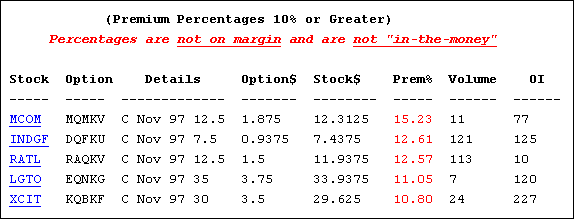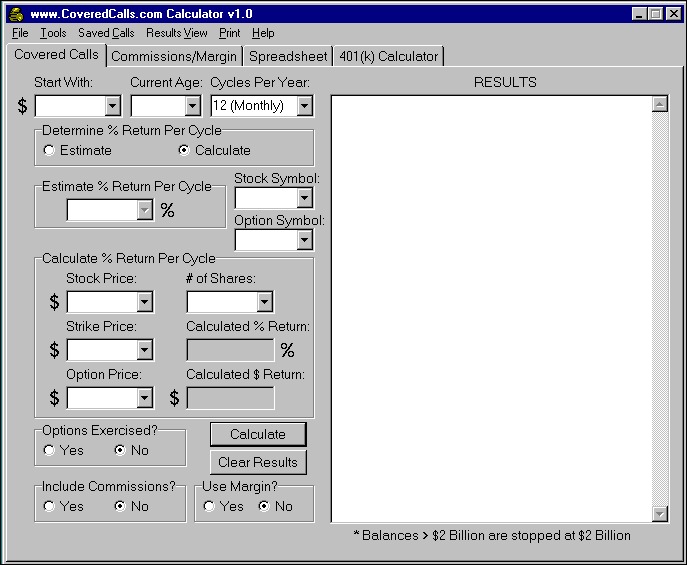If you don't have a good understanding of basic options terminology and theory, please
review the Characteristics and Risks of
Standardized Options. If you don't have an understanding of Covered Call basics and
strategies, we would suggest purchasing our Covered Call Resource
Guide.
Also, download the free demo of the
www.CoveredCalls.com calculator if you haven't already done so. It will make our
discussion on writing Covered Calls much easier to understand and it will be a very
valuable tool in modeling your decision criteria.
The Covered Call writer can take one of two approaches to writing a Covered Call:
A) Buy-Write: Buy stock and simultaneously sell an equivalent number of call
options against it.
B) Overwrite: Sell call options against stock that is already owned.
The sale of a Covered Call option obligates the seller or writer to deliver stock at
the strike price of the
option if the option buyer chooses to exercise his or her
option. The term "covered" refers to the fact that the option writer's
obligation is covered by ownership of the underlying stock. For assuming this obligation,
you are paid a premium
at the time you sell the call.
Let's look at the FREE data offered on the www.CoveredCalls.com site and plug the
numbers into the www.CoveredCalls.com calculator. Once we model the data and calculate the
premium % returns, you will begin to see the tremendous potential of writing Covered
Calls.
Assumptions:
- You have reviewed basic options terminology and theory from the Characteristics and
Risks of Standardized Options online document or from the pamphlet you received from your
broker.
- You have established a brokerage account that will allow writing covered calls and, if
you desire, the ability to trade on margin.
- You have reviewed Covered Call basics and strategies in The Covered Call Resource Guide.
Procedures:
1) Access one of the Premium Percent option listings from the front page of
www.CoveredCalls.com.
2) Identify a stock that meets your risk versus return criteria. You may choose the
highest Percent Return Premium Covered Call option or you may want to choose another
option in the listing and do some research to identify the strength of the underlying
stock.

3) Single click the linked stock symbol. This will take you to Profile, Research, News
and Chart information of the underlying stock. View the criteria you consider critical to
evaluating the underlying stock such as 52-week High/Low, Valuation Ratios, Profitability,
Financial Strength, Volatility, Latest News, etc.
4) Select the "back" button in your browser until you are back to the Premium
Percent option listing screen.
5) Run the www.CoveredCalls.com Calculator. Select the "Cycles Per Year" that
applies to your Covered Call option candidate. For example, if you choose a Covered Call
candidate that is 30 days out, you would select 12 Cycles Per Year. Set the
"Determine % Return Per Cycle" button to "Calculate" and enter the
Stock Symbol and Option Symbol in the appropriate field.

6) Enter the Stock Price, the Strike Price, the Option Price or Premium, and the # of
Shares in the available fields.
7) Select the buttons that apply to your trading criteria: Commission Fees and Margin.
8) Set the "Options Exercised?" button to "yes" and click
"Calculate". View the Calculated % Return and Calculated $ Return fields for
investment return.
9) Go through the same steps with the "Options Exercised?" button set to
"no" and view the difference in investment return.
10) Place an order with your broker to either do a "buy-write" or
"overwrite" a stock you already own. Because every on-line brokerage order entry
screen is different, you will need to consult with you broker for instructions on placing
Covered Call orders on-line.
Now see a real life example... |